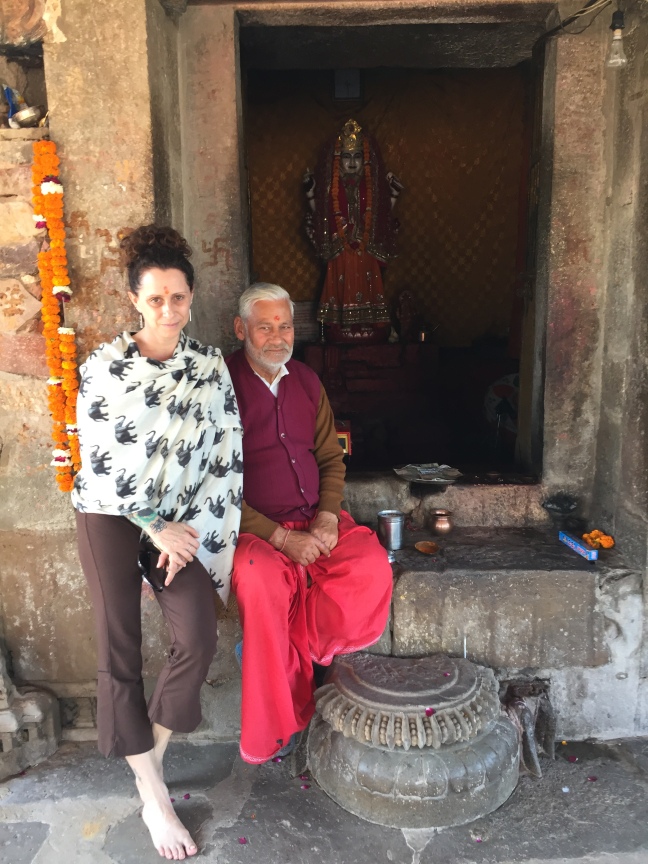January 30, 2017
After a quick one-day, jet-lagged visit to Delhi, (which I will summarize after my return visit on the way home) we set off for Jaipur, taking a long detour to the small village of Abhaneri in order to visit one of the oldest baoris (step-wells) in India: Chand baori.
Step wells are old structures unique unto India. A perimeter of long criss-crossing staircases were built around vast, deep holes in the ground that either occurred naturally or were excavated. During monsoon season these vast wells would collect water that would be used long after the rains stopped. The lower the water levels got, the deeper they could descend via the stairs to retrieve it.
Although I had only ever visited one other step-well before on my last trip (in Delhi) I became slightly obsessed with these ancient structures. Their aesthetic and functionality from days long gone have a sort of mystical effect, and their appeal led me to explore options for visiting more whenever the opportunity arose.
As per my usual method of operation, part of the appeal to visit Chand baori was it’s somewhat remote location (read: very few tourists) and I had visions of climbing down into this well like you can in the Delhi locale, but unfortunately the steps here have been partitioned off, safety and preservation both being clear concerns. Still, the gorgeous symmetry and artistry remains alluring from our vantage point above. This particular baori was built for a King in the 8th Century and the structures surrounding the well show it’s regal purpose.
Adjacent to the well was the King’s temple and we spent time photo-documenting the site (as we love to do!) when some delightful local children joined our fun.
From here we linger in the village for a cup of chai, but this was no ordinary chai. The tea itself was delicious as always (fueling my chai obsession from the last trip) but the gift here was in the cups. Traditionally you see chai being served on the streets in tiny plastic glasses, but here the earthy, clay pots they used gave the tea an entirely different taste and texture. In general, old world traditions still have immense value in India, but in the countryside that is particularly so. These little clay cups were being made right around the corner and after we finished drinking, we paid the artisans a visit and were privy to their process.

Overall, this was an intimate, authentic experience, and exactly why I prioritize getting off the beaten tourist track.

——
Headed now toward Jaipur, we stop just outside the city at Galtaji, an old temple affectionately known as “The Monkey Temple”. Nestled between rocky cliffs, this place is still in use for daily prayers but is in quite a state of disrepair, which only adds to its charm. It is dusk when we arrive, and the man giving us our very informal ‘tour’ is a humble man who has dedicated his life to feeding the wild monkeys here. Many forgotten years ago I had seen a documentary talking about people in India who are committed to caring for and feeding animals and as we approached the temple the familiarity of it triggered my memory of seeing this place on television.
This man began feeding the monkeys as a child and his relationship with these wild creatures many decades later is clear. I have been to other places where monkeys integrate with the public, and caution is always warranted with these somewhat aggressive and wiley creatures. Here, most of what we saw were docile (but hungry!) animals, save for the occasional screeching outburst when some young monkey didn’t respect the pecking order.
Most of these little guys obeyed his commands to back off if their behavior got too wild near us, but when left to their own devices they simply wanted more peanuts. Clearly, they have become less wild here at the temple, but it’s no free-for-all. You are asked to stick to the peanuts they provide and not to provoke them in anyway. We watch as hundreds of them descend from the surrounding cliffs down onto the temple grounds or go back up to their homes. It is absolutely delightful.
As darkness descends upon us, exhausted by the excitement, lingering jet lag and long hours in the car we head toward our home for the next three days, Jaipur.












Stepwells are indeed amazing structures. We have mapped around 800 stepwells (with accurate GPS coordinates, and pictures) on our collaborative Stepwell Atlas (see http://www.stepwells.org or the Stepwell Atlas android app). There are many stepwells in and around Jaipur which are hardly visited / known about.
LikeLike